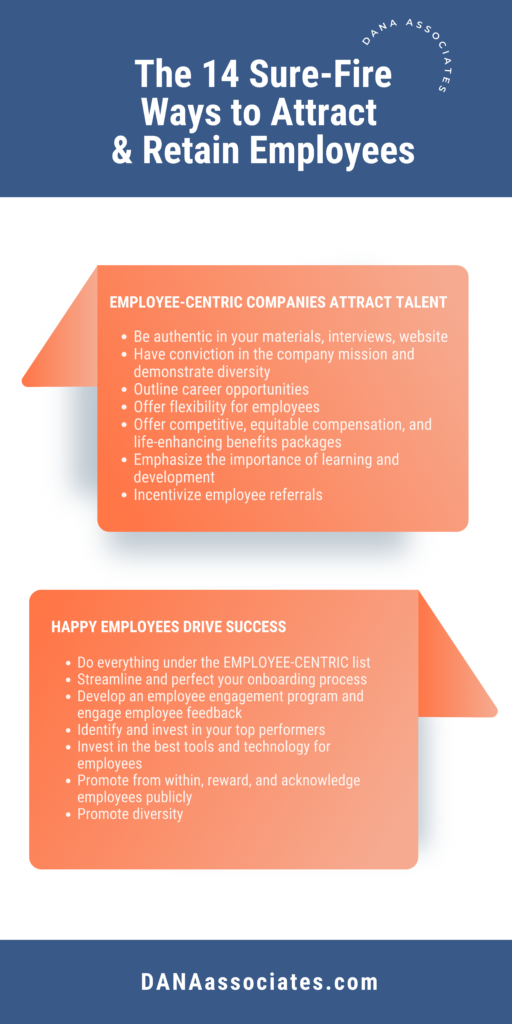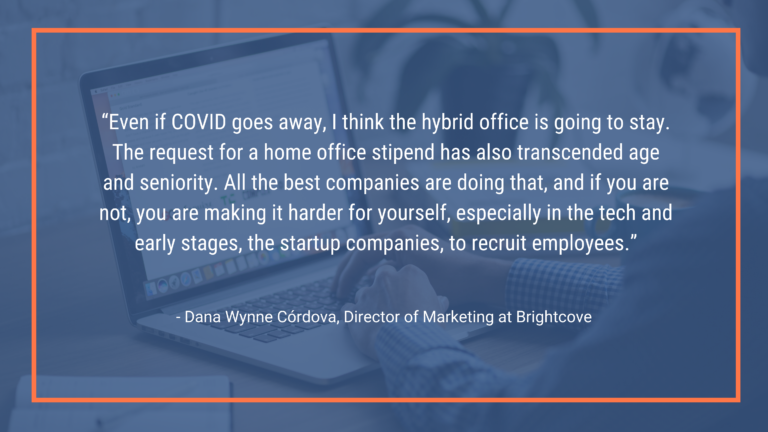
Some call it the “great resignation,” the “big quit,” and even, perhaps more appropriately, the “great reshuffling.” More than 47 million Americans left their jobs in 2021, with a record-breaking 4.3 million Americans voluntarily leaving in August.
Of all the pundit ponderings of the reasons for this exodus, one overarching observation resurfaces: Even as they face financial insecurity, individuals who quit their jobs during the COVID-19 pandemic were motivated by more than financial reward. Instead, job seekers are embracing a broader sense of purpose, work-life balance, and quality of life as they consider their next career moves.
In today’s market and beyond, central to a company’s ability to retain and attract employees is sustaining and developing a positive corporate culture. But what does that actually mean? In this article, we call on experts to help us break down how to retain employees by devoting time and resources to their company culture, to support company success and profitability in the long and short term.
Adopt Employee Retention Strategies
An employee-centric model acknowledges that people are the core of the company and prioritizes the needs of the worker as much as it does the customer. The work experience is personalized and put on a path of continual improvement, much as companies do with the customer experience. This idea of an employee-centric workplace is gaining traction as a prerequisite for operating successfully in the workplace of the future.
The Business Roundtable, for instance, released in 2019 a new “Statement on the Purpose of a Corporation.” The statement, signed by 181 chief executive officers from major U.S. companies representing more than 20 million employees and $9 trillion in annual revenues, outlined a “modern standard for corporate responsibility” that named employees as stakeholders, and backed away from versions since 1997 that said “corporations exist principally to serve shareholders.”
Even though the release was met with some skepticism as to how concrete the follow-through would be, the idea of employee retention strategies in the workplace is catching on. It is certainly how one of the Roundtable’s members, Adobe, earned its lofty position as the number one U.S. company for happy employees in 2021. Notably, during the pandemic, and across all departments, from marketing to design and engineering, its employees gave distinctly positive reviews.
The company, despite having more than 24,000 employees worldwide, found distinct approaches for connecting employees through biweekly sessions and through its annual diversity and inclusion event. There were continual employee surveys; all-company meetings; and focus groups to define and respond to employee needs. And as such, Adobe found these ways to address a possible employee disconnect in changing times and to ensure satisfaction:
- Monthly companywide days off
- 20 new paid days off for employees effected by pandemics or natural disasters
- Increased flexibility in work schedules
- Increase wellness reimbursements, to $600 per year
When we asked “how to best retain employees within a sales organization,” Teresa Regan said, “A focus on employees must come straight from the top.” Teresa Regan has more than 25 years of experience in human resources, primarily in the biotech space and most recently as chief people officer at Neon Therapeutics (acquired by BioNTech US, Cambridge, Mass). In her last two years at Neon, the company was named one of the top places to work in Massachusetts by The Boston Globe. “The best environments start with a CEO who truly cares about people and understands that employees drive success,” Regan said. “Also, a leader who ‘gets it’ makes sure there is an excellent HR resource who can look out for the best interest of employees while also understanding the company’s business needs. You’re not going to have the kind of culture that attracts and retains good people, and has a finger on the corporate pulse, without that.”

Be Authentic in your Materials, Your Interviews
Brand authenticity not only exists for customers, but employees as well. Candidates deserve an environment of full disclosure in their interviews, understanding who they will work with; how they fit in the organization on a day-to-day basis; the tools available to them; their territory; the support they get; and how they will be evaluated. This is the starting point for successful employee retention strategies.
Authenticity is important in all your materials, starting with your website. At Neon, the website was essential for honestly and openly relaying the company’s mission and values, Regan said. “You could see what our values were, what we wanted to accomplish,” and the kind of employee the company thought would thrive there. Candidates are adults making decisions about their careers, Regan said, and it’s necessary to treat them with respect and share both company strengths and areas needing improvement. No company is perfect and from the get-go you are being real and fostering trust.
“I can’t tell you the number of times in the hiring process there were bigger companies that could pay more, but we got the top talent because they wanted be valued, and that was apparent by the interview process,” she said.
Similarly, it’s important for companies to demonstrate authenticity by revealing evidence to back up claims of growth and expansion for both attracting and retaining employees, said Dana Wynne Córdova, director of marketing for the Americas region of Brightcove (Boston).
“You can say, ‘We are growing so fast.’ Okay, but why? Have leads grown? How?” she said. A candidate will see through exaggerated claims “in a heartbeat.” It matters that there is truth to the statements a company makes about its sales numbers. “Otherwise, you’re going to start to lose people,” she said. “Don’t overstate, and back the claims up with hard data and reasons.”
How to Retain Employees in 2022? Embrace Flexibility
Work flexibility — it’s not just for millennials anymore, according to Córdova, and it includes flexibility in work location, daily hours, and length of work week.
For recent hires, Córdova noticed the request for flexibility in workplace location went beyond millennials to span all generations and sectors of the employment pool — parents, singles, older and younger candidates, and more.
“Even if COVID goes away, I think the hybrid office is going to stay,” she said. And as such, the request for a home office stipend has also transcended age and seniority, she said.
“All the best companies are doing that, and if you are not, you are making it harder for yourself, especially in the tech and early stages, the startup companies, to recruit employees,” Córdova said. “It’s a big draw for the talent those companies are wanting to hire.”

When discussing how to retain employees post-COVID, we’ve noticed flexible work schedules have become a selling point. Companies like Panasonic, San Francisco-based Bolt, an online checkout technology company, and others are either experimenting with a 4-day work week or making it permanent after test-runs.
“That type of flexibility is appealing,” Córdova said. “I know people who have turned down more money for it. Tech companies that have switched to a 4-day work week have not suffered from productivity, and have even exceeded productivity.”
These policies started as an expression of recognition by companies of how hard the pandemic has been, but some may stick as employees feel acknowledged and recognized for their humanness. At Brightcove, for instance, Córdova says a company-wide policy has been instituted for meeting-less afternoons on Friday, when employees are encouraged to sign off by 3 p.m. and minimize requests of other people’s time.
“It’s supposed to be a recovery time,” Córdova said. “It is easy for a company to give you time back on a Friday. And I think companies are more likely to win with these humanity bullet points more than anything.”
Effective employee retention strategies, though, depend on those same companies “walking the talk,” she said. You can’t say half-day Fridays, and “then the boss is demanding Friday reports.” To cement the company’s commitment to candidates as members of the team, job descriptions could list not only requirements and duties, and then qualifications, but a third bulleted section. “It doesn’t have to be flowery,” Córdova said, but a statement of flexible work times, half-day Friday’s, wellness programs, and the like.
How to Retain Employees in 2022? Promote Diversity
One of the best ways to attract and retain employees and set the company up for success is to have a diverse employee base and leadership team, Regan said. “In my experience, the companies that understand the true benefit of diversity have excellent engagement — employees want to be there; everyone has a place.”
For companies that do embrace diversity, there is a measurable return. Companies in the top quartile for workforce ethnic and cultural diversity outperformed those in the fourth quartile in profitability by 36 percent, an increase of 3 percent in two years. When adding in gender, companies in the fourth quartile were 27 percent more likely to underperform.
Diversity is directly linked to hiring, both in the mix of people and in their attitudes, Regan said. “Every single interview done at Neon, we talked about diversity. I would ask candidates, ‘How do you feel about working with all different kinds of people — different races, ethnicities, LGBTQ+ employees, those who come from different backgrounds, schools and degrees, those with English not being their first language, a variety of personality styles, problem-solving skills… people who may be different than you?’ That was just an important question, and helped potential employees know that we considered diversity an incredible strength.”
Equally so is how diversity is represented in leadership. “Many people looking for jobs will assess a company’s commitment to diversity by looking at the website. For example, it’s pretty clear if you look at the management team pictures and they all look the same,” Regan said.
Schedule Regular Performance, Coaching Sessions
Sales leaders and managers who use opportunities to monthly, weekly, or even daily provide regular micro-engagements to mentor and coach employees in the context of their work build trust and add value to their employee’s work experience in real time.
This more continuous approach shifts away from a year-end “looking backwards” performance review of employees that many companies have phased out.
“It’s so outdated and not helpful,” Regan said. “For employees who are engaged and want to get better in their jobs and are excited to learn, it is not a motivator. This can be especially true for younger employees; they want feedback in real time and not necessarily in 3, 6, or 9 months.” Understanding incrementally what they are doing well now, what can be done better, and how, allows for many more moments for supervisors and employees to work together toward improvement. Evaluations shift from a system of penalization, where employees are dinged on the things they don’t do well, to one of improvement and accelerated learning. This is a key retention strategy and simply common sense for companies who want to get better and better.
“You don’t want employees receiving more feedback on their Instagram post about their lunch choice than how they are doing at work,” Regan said.
Develop Employee Engagement Initiatives
Those companies that focus on excellent employee retention strategies have employees who want to be there. The result? Companies have greater returns — read: the companies are rewarded.
Engagement is as a function of diversity, which isn’t focused only on race and sexual orientation, Regan said, but on different points of views and life experiences.
“For instance, how are meetings run? Are the people who run the meetings making sure that everyone on the team has a voice?” she asked. Are employees encouraged to brainstorm without concern for being chided for providing an alternative viewpoint? How about an employee who has less than 20 years’ experience in an industry: Would they be given space to contribute their input as much as someone with more tenure?
When interviewing on how to retain employees, we’ve noticed employee engagement can also be measured through volunteerism. At Neon, employees led efforts to read to third graders in the public school system; invite community college students to do mock interviews; maintain an internship program for young people to experience work in the biotech space; and make meals for the homeless or participate in a walk for AIDS, Regan said.
Although HR certainly generated volunteer opportunities, employees participated in and spearheaded activities they were interested in. “There was so much employee involvement that it was an exciting and healthy place to be,” she said. “There are so many things that can be done that don’t cost a lot of money. I know our employees felt we cared about them, because we did.”
Provide Learning, Development Opportunities
Regular career development opportunities help employees feel like they are learning and growing on the job.
“Having some level of career development to help employees develop as leaders, and develop their careers, a 2-3 year trajectory, I definitely discuss and mention as a cultural pillar in interviews,” Córdova said.
Compensate Competitively, Equitably Creatively
Of course, none of the above approaches to attracting and retaining talent replace strong compensation and benefits packages. They must be in place as well. Making sure you know the market and are paying at or above is important. Excellent health, dental, and vision plans need to be your foundation, with creative life-enhancing benefits added on, Regan said.
When interviewing on how to retain employees, we’ve noticed a deciding factor may also be whether 401(k) plans are offered, even if the company provides no match. “Employees are smart, and they know they have to start to save for retirement,” Regan said. Companies would do well to get a 401(k) in place as soon as possible regardless of size.
Add-ons can include employee assistance programs (EAPs) that provide support to employees and their families and allow them to stay more focused on their jobs. Examples include counseling and short-term coaching services; concierge services for finding elder or childcare, summer camps, and even dog walkers; and help with addiction, financial troubles and more. Additionally, offering in-house meditation and yoga classes, and anything else that help employees effectively manage stress, go a long way to helping employees know you care.
“You look at the dollar amount spent on these initiatives, in the scheme of our budget, and it was nothing, and they were the most used services,” Regan said. “Having a massage therapist come in every other week and provide 15-minute chair massages to our hard-working staff, for instance, ranked as our number one added benefit. Employees loved it!”
Of course, a critical element in a discussion of compensation packages, harkening back to diversity and authenticity, is pay parity — employees being paid equally for jobs done at the same level, with no gender inequities. Paying equitably “is the right thing to do, and the right business move. Companies must ensure that their practices are not discriminating in any way,” Regan said.
Plus, in sales, it is important companies make sure their compensation plans are reasonable, and success is attainable, Córdova said. Those who achieve success should receive public recognition for an outstanding job, such as a mention at an all-hands meeting or a SPIF.
“Take time with your comp plans, and ensure rewards are in place so that when employees do exceed quotas, they receive compensation and bonuses for that,” Córdova said. “Things can’t be impossible, or your salespeople will be out.”
In a tight labor market, the question becomes what are your corporate goals? Are they to thrive and be profitable? If so, it’s important to dedicate, specifically and clearly, time and financial resources to developing a good corporate culture. A set of objectives, supported by an experienced HR professional, acknowledges the well-being of employees as a pillar of a company’s ethos, and subsequently contributes to a company’s success.
“Often there are these brilliant people in leadership roles who don’t connect the dots that people make up the company — they are the ones actually doing the work. Why wouldn’t you make sure that they are happy and engaged and want to be there?” Regan asked. When you do, you ensure loyalty and the longevity of your employees.
Still Wondering How to Retain Employee Post covid? Let Dana Associates Help
Attracting and retaining the best talent starts with effective recruiting. DANA Associates is your critical link to sales candidates who you can hire with confidence. From hiring a sales leader to building your sales team from the ground up, we will find you the most highly qualified candidates. To learn more about our in-depth, personalized process, contact us now.

